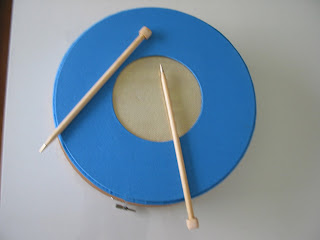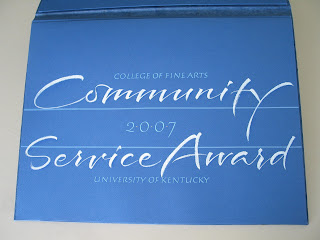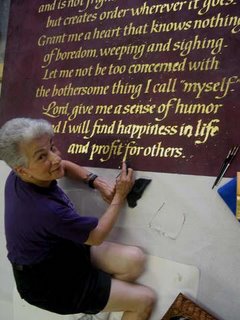The Columbus Jewish Film Festival award committee asked me to create an award for the Media Arts Department (Film/Video team) of the Wexner Center for the Arts at The Ohio State University, given for their work in fostering independent films and filmmakers in the Columbus area. The framework for the award is based on what I decided was the most generic and universally recognized physical symbol of 'film' around the world--the simple film canister. The finished award is 9 times actual size, built to scale, about 18" tall. Hand lettered on three frames of the 'film,' the text reads as the strip is pulled out of the canister--from right to left--letting the whole award work also as a silent nod to the donors of the award, in its allusions to both Hebrew and to the scroll form of the Torah.
 This flash image shows the rich black silk moire bookcloth exterior of the 'canister':
This flash image shows the rich black silk moire bookcloth exterior of the 'canister': Along with stops at both the beginning and end of the film roll, I included the turning spindle for winding and unwinding it.
Along with stops at both the beginning and end of the film roll, I included the turning spindle for winding and unwinding it. It had been raining for days just before the award was to be picked up by the committee for the ceremony. Worried that it might get damaged in transit, I decided, in addition to boxing it, to make the protective cover shown below to prevent its tipping or shifting in the box. I was just trying to protect the piece, but one of the film festival award committee's chairs exclaimed as I put it on after showing the piece, "It's a Torah cover!" If I'd been smart enough to think of it that way myself, I would have made it out of something more elegant than thin corrugated cardboard.
It had been raining for days just before the award was to be picked up by the committee for the ceremony. Worried that it might get damaged in transit, I decided, in addition to boxing it, to make the protective cover shown below to prevent its tipping or shifting in the box. I was just trying to protect the piece, but one of the film festival award committee's chairs exclaimed as I put it on after showing the piece, "It's a Torah cover!" If I'd been smart enough to think of it that way myself, I would have made it out of something more elegant than thin corrugated cardboard.

~~~~~~~~~~
The previous year's award went to acclaimed young tenor Gregory Turay. Gregory's achievements in his career thus far are stunning, with award after major award for his vocal virtuosity. I had been moved beyond tears by his performance in A Room with a View, an opera about Italian immigrants in New York in the 1920s--a story that paralleled by own family's. I hoped that the award I created would provide a visual equivalent of the effect that the rich clear colors of his voice have on everyone who hears him sing.
 Set in a grossgrain cloth-covered case with bone clasps, the award is large (like Gregory's voice). The four blue sections (two of which carry the award text) are collaged to the swirled color paste-paper behind his name, which itself was lettered, then cut from a single sheet of blue paper and collaged to the paste paper ground. Nestled through the swirling lines of the ground are the many major roles he has already performed around the world. Gracious beyond words despite his celebrity, Gregory asked that this image be taken of us together, holding his award.
Set in a grossgrain cloth-covered case with bone clasps, the award is large (like Gregory's voice). The four blue sections (two of which carry the award text) are collaged to the swirled color paste-paper behind his name, which itself was lettered, then cut from a single sheet of blue paper and collaged to the paste paper ground. Nestled through the swirling lines of the ground are the many major roles he has already performed around the world. Gracious beyond words despite his celebrity, Gregory asked that this image be taken of us together, holding his award.
~~~~~~~~~~
This next award was created for Todd Lacey, producer of the international productions of The Lion King and several other Disney stage musicals. Todd's background as a theatre buff began as a student in the UK classroom of one of my husband Alan's early students, a felicitous but unsolicitied connection. I learned this when I was able to connect with two of Todd's earliest theatre buddies at UK. Bitten by the bug, the trio had decided to go to the Big Apple to break into 'theatre' and ended up producing a play in the Village that sold out all its performances. Todd stayed and ended up being hired by Disney Studios. It was these friends who also told me of Todd's deep love for Kentucky and frequent return visits, despite a career that now has him year after year trotting the globe. This gave me the idea of a traveling executive's attache case that would open with his world travels and ultimately bring him home to Kentucky and to his educational roots at UK.
I'm afraid I went all out on this one, but Todd's career as a producer of musicals seemed to beg for something 'theatrical.' Yet Todd himself, from all I learned, is a disciplined, hard working guy not given to splash, so I had to restrain the impulse to go over the top...though I admit to having more fun with it than I perhaps should have, including mining the OSU Theatre Research Institute's extensive holdings for visual materials on his productions, and the Kentucky Tourist Information Service for great images of Kentucky attractions--to incorporate into the official 'passport'--issued by UK--tucked into the center section of the attache case. Our membership in the Ohio Auto Club proved the 'passport' for getting all the maps I needed.
Shown here is a projection map of the world set into the inside cover of the case. The text of the award begins on the first separator with Todd's name cut out of blue paper and collaged over a map of Kentucky. I saved those cut-out letters, by the way, and slipped them into the clear plastic " name tag" attached to the handle of the case--a bit of which is visible in this image. Below is the last separator of the case opened. The 3-D pop-up is of the UK logo--a wonderful combination of two chunky initials that uses the spire of the university's chapel as the counter between them. I've always loved that logo, and this isn't the first time I've used it. But that wasn't the end of it: a close look at the 'courtyard' in front of the chapel shows a radiating pattern of holes--escape holes for the music box element below playing "My Old Kentucky Home."
Below is the last separator of the case opened. The 3-D pop-up is of the UK logo--a wonderful combination of two chunky initials that uses the spire of the university's chapel as the counter between them. I've always loved that logo, and this isn't the first time I've used it. But that wasn't the end of it: a close look at the 'courtyard' in front of the chapel shows a radiating pattern of holes--escape holes for the music box element below playing "My Old Kentucky Home."
~~~~~~~~~~
Sculptor John Henry was the recipient of this award. From a long line of steel-drivin' men (I'm not kidding), John fashions his massive public sculptures from huge slabs and rods of heavy metal. Yet, by using bright and, very often, primary colors coupled his innate sensitivity to balance--where an inch either way would destroy the illusion of perfectly countered weights--he gives them a sense of exquisite delicacy and lightness that totally belies their mass and material. I concluded from reading what was said of his work that he must arrive at these delicate physical and visual balances by mathematically calculating the sizes and shapes of the individual pieces in a given work--like pieces in a Fibonacci puzzle. I later found out, directly from him, that he actually decides all this "intuitively." But no matter, I had a great time creating this puzzle-like award in which all the pieces do relate mathematically...and can be used to create a sculpture, albeit a light-weight one only the tiniest fraction of the scale John normally works in. ...and, frankly, I still suspect there are mathematical ratios in his works that could actually be calculated and would prove very interesting.
 Turned over, the canvas-covered pieces still fit the box neatly, only on this side they contain the hand-lettered text of the Distinguished Alumni Award.
Turned over, the canvas-covered pieces still fit the box neatly, only on this side they contain the hand-lettered text of the Distinguished Alumni Award.

~~~~~~~~~~
Donna Boyd, the recipient of this award, is creator of The Center for Old Music in the New World--dedicated to performing medieval musical works live on period instruments for contemporary audiences. To this end, she will not even consent to be recorded. Her award is based on a medieval antiphonary--the larger than life musical texts used for choirs of that period. In an age before movable type printing, these books were produced entirely by hand, so usually only one book existed for each "voice" (alto, soprano, etc.) and it was placed in front of the entire group of singers for all to sing from. I happened to come across two consecutive leaves of one such antiphonary, giving me four pages of continuous musical notation to which I could set a considerable portion of the award text. Shown above is the opening spread of the antiphonary, built to actual size, 22" x 3o". A later page follows below. Along with the Wexner Film Award, this was exhibited in August 2007 at the Mansfield Arts Center, Mansfield, Ohio.
I happened to come across two consecutive leaves of one such antiphonary, giving me four pages of continuous musical notation to which I could set a considerable portion of the award text. Shown above is the opening spread of the antiphonary, built to actual size, 22" x 3o". A later page follows below. Along with the Wexner Film Award, this was exhibited in August 2007 at the Mansfield Arts Center, Mansfield, Ohio.
~~~~~~~~~~~
Tim Lake is an extraordinary banjo artist, combining fiddling virtuosity with lyrics that provoke his listeners to think deeply about life and human affairs. His humor is sardonic, cajoling, cutting, touching, full of empathy for the human condition and human foibles--all at once. I continue to listen to his CDs as I drive across the country to workshops. Invariably he gives me something I have to listen to over and over, then turn off to think about its implications for a long, long time. For his award I wanted to reference his love affair with the banjo, but without the result being obvious from the outset. Closed, the award appears to be a very unassuming squat 'pillbox,' about 12" in diameter, 2" deep, with an exterior of light blue suede.
For his award I wanted to reference his love affair with the banjo, but without the result being obvious from the outset. Closed, the award appears to be a very unassuming squat 'pillbox,' about 12" in diameter, 2" deep, with an exterior of light blue suede. But, when the lid is lifted, turned upside down and placed under the box bottom--voila! It becomes a 'resonator' under the banjo head, on which the text begins. The lettering of the award was done with a very flexible pointed nib, using flicking movements simulating strumming as the basis of a lively alphabet design.
But, when the lid is lifted, turned upside down and placed under the box bottom--voila! It becomes a 'resonator' under the banjo head, on which the text begins. The lettering of the award was done with a very flexible pointed nib, using flicking movements simulating strumming as the basis of a lively alphabet design.

Unfolded, the arm opens out again, into two more sections , with the remaining text. A final unfolding completes the banjo arm. A close look at the middle of the arm shows a white button--for the 5th string.

The completed award, best shown where it belongs:
Another element of Tim's life is the his marriage to Myuki, whose Japanese heritage pervades much of his work and sensibilities. I had wanted desperately to include something of her in the award, so central did I believe she was to his work, but try as I might, everything seemed 'tacked on,' not organic, so in the end I had to let it go. You can imagine what went through me then when, upon meeting Myuki right after the award ceremony and telling her of my struggle to include something of her in the award, she responded, "But you did. There's a Japanese instrument that opens just that way."




























